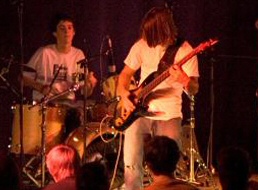
|
In focus - Power chords
 The Power chord
The Power chord
Everybody's heard of it, most people don't know what it really is - or simply assume it means playing a REALLY loud chord.
Let's have a closer look at it.
In music, the term power chord refers in the broadest sense to a chord that remains euphonious (err... for the non-geeks, that means 'sounds good') when distorted by amplification.
What's a Power Chord
Specifically, the term refers to the powerful and distinct sonic effect caused by the combination of two pitch classes separated by the interval of a perfect fifth (or its inversion, a perfect fourth) when subjected to a degree of distortion, usually through adequate amplification or other electronic processing, (e.g., a fuzz box). It is sometimes notated 5, as in C5 (C power chord).
The term arose among rock guitarists, who found that such a note combination (arrived at by omitting the interval of a third from major and minor chords) allowed for much greater levels of distortion and 'power' without causing the instability and dissonance associated with all other chords played at similarly high distortion levels; while, at the same time, preserving the chord's diatonic functionality.
Even normally consonant major and minor chords can sound dissonant and unstable when distortion is introduced. This is because they contain the interval of a third which, although consonant, is classed as an imperfect consonance. That is, it contains elements of dissonance due to certain overtones within each note's respective overtone series forming dissonant intervals with each other. Normally such clashes, which are barely audible, are a desirable feature, serving, as they do, to subtly colour the interval and impart such subjective qualities as sweetness, joy, sadness, etc. normally associated with major and minor chords.
Introducing distortion to the notes of such intervals, however, causes drastic modifications to the relative intensities of each note's overtone series, which combine to form unpredictable sum and difference frequencies, resulting in an increased and usually unacceptable level of dissonance.
Omitting the interval of the third from the chord eliminates such clashes and results in the power chord structure as detailed above. The respective overtone series of the remaining perfect intervals match to a very high degree and combine to produce the distinct and stable 'raw power' sound that is the 'trademark' of power chords.
Although the use of the term 'power chord' has, to some extent, spilled over into the vocabulary of other instrumentalists, namely keyboard and synthesiser players, it remains, essentially, a part of rock guitar culture and is most strongly associated with the overdriven electric guitar styles of hard rock, heavy metal and punk rock, etc. The fact that power chords are also physically easy to play, ensures their continued popularity.
Possibly the single guitarist most associated with the power chord is the Who's Pete Townshend. His technique famously features his trademark "windmill", a full sweep of the arm used to strike a loud, powerful chord.
Many young and/or beginning guitarists, especially those who teach themselves to play by emulating other guitarists from records, pick up basic power chords (especially A and E) first, before learning "proper" chord shapes and other more formal techniques. For new guitarists, power chords are often the quickest route to playing popular music on the guitar without a lot of training or practicing.
Essential features
There are two essential features of power chords:
1. Apart from octave doubling, which is optional, the chord must contain no intervals other than a perfect fifth (or its inversion, a perfect fourth).
2. The chord must be played with an element of distortion, preferably applied by electronic means.
This an important consideration. Classical guitars can produce exactly the same intervals, but without distortion they are simply playing bare fifths and not power chords. Other instruments, such as ukeleles, mandolins, harps and xylophones would have an even greater struggle to produce convincing power chords, although they can play the required notes with ease.
Desirable features
It is generally agreed that power chords sound best when the following conditions are met:
1. They sound best when the intervals lie within a single octave. That is, the contained perfect 5th (or 4th) should be a simple interval rather than a compound interval, as this results in the closest matching of overtones (notwithstanding the slight discrepancy between the pitch ratios of overtones and the pitch ratios of notes fretted in accordance with equal temperament).
2. They are mostly played with just 2 or 3 notes. Other notes can be added by further octave doubling but this is rarely done, as too many notes tend to weaken the chord's simple purity.
3. They should not be pitched too low or too high. When played too high they lack depth and power. When played too low, such as in the lower register of bass guitars, they tend to sound unclear and unstable. On guitar, their optimal range spans all but the very highest positions on the fretboard within the lowest 4 strings.
Since power chords lack a third, they are ambiguous as to mode: they are neither major or minor. However, the musical context often implies or provides a frame of reference for major or minor. For example, in the progression bVI-bVII-I, the I chord is implied to be minor by the bVI chord, and other instrumental parts may confirm this during the one chord by playing a minor third, or may contradict this by playing a major.
People who don't like Power Chords - The Consecutive fifths criticism
The criticism sometimes levelled at the use of consecutive power chords, i.e., that they violate an important rule of harmony, is largely based on a misunderstanding of the rule.
The rule in question prohibits the use of consecutive fifths or octaves in certain situations. It applies to the common practice period of classical music, in which chords, originally, were formed as the result of individual parts, such as voices, combining. Following the principle known as voice leading, the individual parts maintain their identities throughout, but if the interval of a fifth or octave is sounded consecutively between any two parts, their individuality may be momentarily lost. This was considered to result in a weakness of harmonic texture and was studiously avoided, especially in the earlier part of this period.
Power chords, however, are not composed of independent parts that happen to coincide. The component parts depend on each other to produce the required sonority and the presence of consecutive octaves and fifths when the chords are heard in succession is seen merely as doubling - a technique often applied in classical music as a way of strengthening or 'colouring' parts that are not being contrasted against each other in harmony.
This article contains text and source material from Wikipedia
|
|



